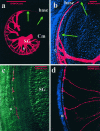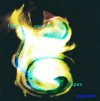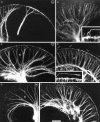Lack of neurotrophin 3 causes losses of both classes of spiral ganglion neurons in the cochlea in a region-specific fashion
- PMID: 9236232
- PMCID: PMC2693053
- DOI: 10.1523/JNEUROSCI.17-16-06213.1997
Lack of neurotrophin 3 causes losses of both classes of spiral ganglion neurons in the cochlea in a region-specific fashion
Abstract
Essential functions of neurotrophin 3 (NT-3) in regulating afferent and efferent innervation of the cochlea have been characterized by comparison of normal and NT-3 mutant mice. NT-3 deficiency has striking, region-specific effects, with complete loss of sensory neurons in the basal turn and dramatic but incomplete neuronal loss in the middle and apical turns. The sensory innervation of inner and outer hair cells was reorganized in mutant animals. Instead of a strictly radial pattern of innervation, the axons of remaining sensory neurons projected spirally along the row of inner hair cells to innervate even the most basal inner hair cells. Innervation of outer hair cells was strongly reduced overall and was not detected in the basal turn. The presence of fibers extending to both inner and outer hair cells suggests that subsets of types I and II sensory neurons survive in the absence of NT-3. Likewise, projections of the cochlea to auditory nuclei of the brainstem were attenuated but otherwise present. Equally striking changes in efferent innervation were observed in mutant animals that closely mimicked the abnormal sensory innervation pattern. Despite these impressive innervation deficiencies, the morphology of the organ of Corti and the development of inner and outer hair cells appeared comparatively normal.
Figures











Similar articles
-
The combined effects of trkB and trkC mutations on the innervation of the inner ear.Int J Dev Neurosci. 1998 Oct;16(6):493-505. doi: 10.1016/s0736-5748(98)00043-4. Int J Dev Neurosci. 1998. PMID: 9881298
-
Spatial shaping of cochlear innervation by temporally regulated neurotrophin expression.J Neurosci. 2001 Aug 15;21(16):6170-80. doi: 10.1523/JNEUROSCI.21-16-06170.2001. J Neurosci. 2001. PMID: 11487640 Free PMC article.
-
Spatiotemporal definition of neurite outgrowth, refinement and retraction in the developing mouse cochlea.Development. 2007 Aug;134(16):2925-33. doi: 10.1242/dev.001925. Epub 2007 Jul 11. Development. 2007. PMID: 17626062
-
The role of neurotrophic factors in regulating the development of inner ear innervation.Trends Neurosci. 1997 Apr;20(4):159-64. doi: 10.1016/s0166-2236(96)01007-7. Trends Neurosci. 1997. PMID: 9106356 Review.
-
Anatomy of cochlear innervation.Am J Otolaryngol. 1985 Nov-Dec;6(6):453-67. doi: 10.1016/s0196-0709(85)80026-0. Am J Otolaryngol. 1985. PMID: 3909832 Review.
Cited by
-
Brn3a is a transcriptional regulator of soma size, target field innervation and axon pathfinding of inner ear sensory neurons.Development. 2001 Jul;128(13):2421-32. doi: 10.1242/dev.128.13.2421. Development. 2001. PMID: 11493560 Free PMC article.
-
Postnatal development of NT3 and TrkC in mouse ventral cochlear nucleus.J Neurosci Res. 2010 Jan;88(1):86-94. doi: 10.1002/jnr.22179. J Neurosci Res. 2010. PMID: 19610111 Free PMC article.
-
Neurod1 Is Essential for the Primary Tonotopic Organization and Related Auditory Information Processing in the Midbrain.J Neurosci. 2019 Feb 6;39(6):984-1004. doi: 10.1523/JNEUROSCI.2557-18.2018. Epub 2018 Dec 12. J Neurosci. 2019. PMID: 30541910 Free PMC article.
-
Unmasking of spiral ganglion neuron firing dynamics by membrane potential and neurotrophin-3.J Neurosci. 2014 Jul 16;34(29):9688-702. doi: 10.1523/JNEUROSCI.4552-13.2014. J Neurosci. 2014. PMID: 25031408 Free PMC article.
-
Anterograde tracing method using DiI to label vagal innervation of the embryonic and early postnatal mouse gastrointestinal tract.J Neurosci Methods. 2007 Jul 30;163(2):213-25. doi: 10.1016/j.jneumeth.2007.03.001. Epub 2007 Mar 12. J Neurosci Methods. 2007. PMID: 17418900 Free PMC article.
References
-
- Berglund AM, Benson TE, Brown MC. Synapses from labeled type II axons in the mouse cochlear nucleus. Hear Res. 1996;94:31–46. - PubMed
-
- Bianchi LM, Cohan CS. Effects of the neurotrophins and CNTF on developing statoacoustic neurons: comparison with an otocyst-derived factor. Dev Biol. 1993;159:353–365. - PubMed
-
- Bianchi LM, Conover JC, Fritzsch B, De Chiara T, Lindsay RM, Yancopoulos GD. Degeneration of vestibular neurons in late embryogenesis of both heterozygous and homozygous BDNF null mutant mice. Development. 1996;122:1965–1973. - PubMed
Publication types
MeSH terms
Substances
Grants and funding
LinkOut - more resources
Full Text Sources
Other Literature Sources
Molecular Biology Databases
Research Materials
